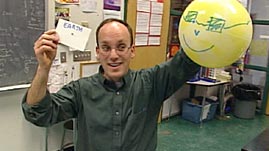Teachers' Domain - Digital Media for the Classroom and Professional Development
User: Preview

Source: WGBH Educational Foundation


A common question for the teaching of science is how to concretize the abstract. It is easy to assume that what is concrete to the science teacher is concrete to the student. However, when students actually work with particular content , the concepts may become too overwhelming in size and scope.
In this light, concrete representations can be a benefit to students’ understanding. By using real-world environments, students can translate difficult ideas or scales into a more intuitive form.
Take the Solar System for example. In his earth and space science class shown in this video, teacher Mark Goldner and his students work together to demonstrate the scale of the solar system’s celestial bodies. They use familiar objects and the school environment to imagine the size and distance of things like Earth in relation to a beach ball model of the Sun.
Classroom objects and the classroom environment can be useful tools to visualize large scale and size. And by translating concepts between physical representations and content knowledge, students have the opportunity to visualize and imagine “nebulous” astronomical phenomena.
 Loading Standards
Loading Standards